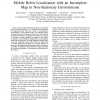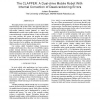20 search results - page 3 / 4 » CAD-Vision-Range-Based Self-Localization for Mobile Robot Us... |
AAAI
1990
13 years 7 months ago
1990
In this article we present a novel, hybrid graph spatial representation for robot navigation. This representation enables our mobile robot to build a model of its surroundings whi...
ICRA
2005
IEEE
13 years 11 months ago
2005
IEEE
— This paper presents a visual attention mechanism for the acquisition of landmarks in an arbitrary scene. The proposed mechanism consists of two consecutive selection stages. Th...
JIRS
2006
13 years 5 months ago
2006
Abstract. Autonomous mobile robot navigation systems are based on three principal kinds of techniques: map-based navigation, map-building-based navigation and mapless navigation. W...
ICRA
2003
IEEE
13 years 11 months ago
2003
IEEE
— One of the fundamental problems of the mobile robots is self-localization, i.e. to estimate the self-position by comparing sensor data and a map. In non-stationary environments...
ICRA
1994
IEEE
13 years 10 months ago
1994
IEEE
This paper presents a new approach to accurate and reliable dead-reckoning with mobile robots. The approach makes use of special properties of our recently developed Multi-Degreeo...


